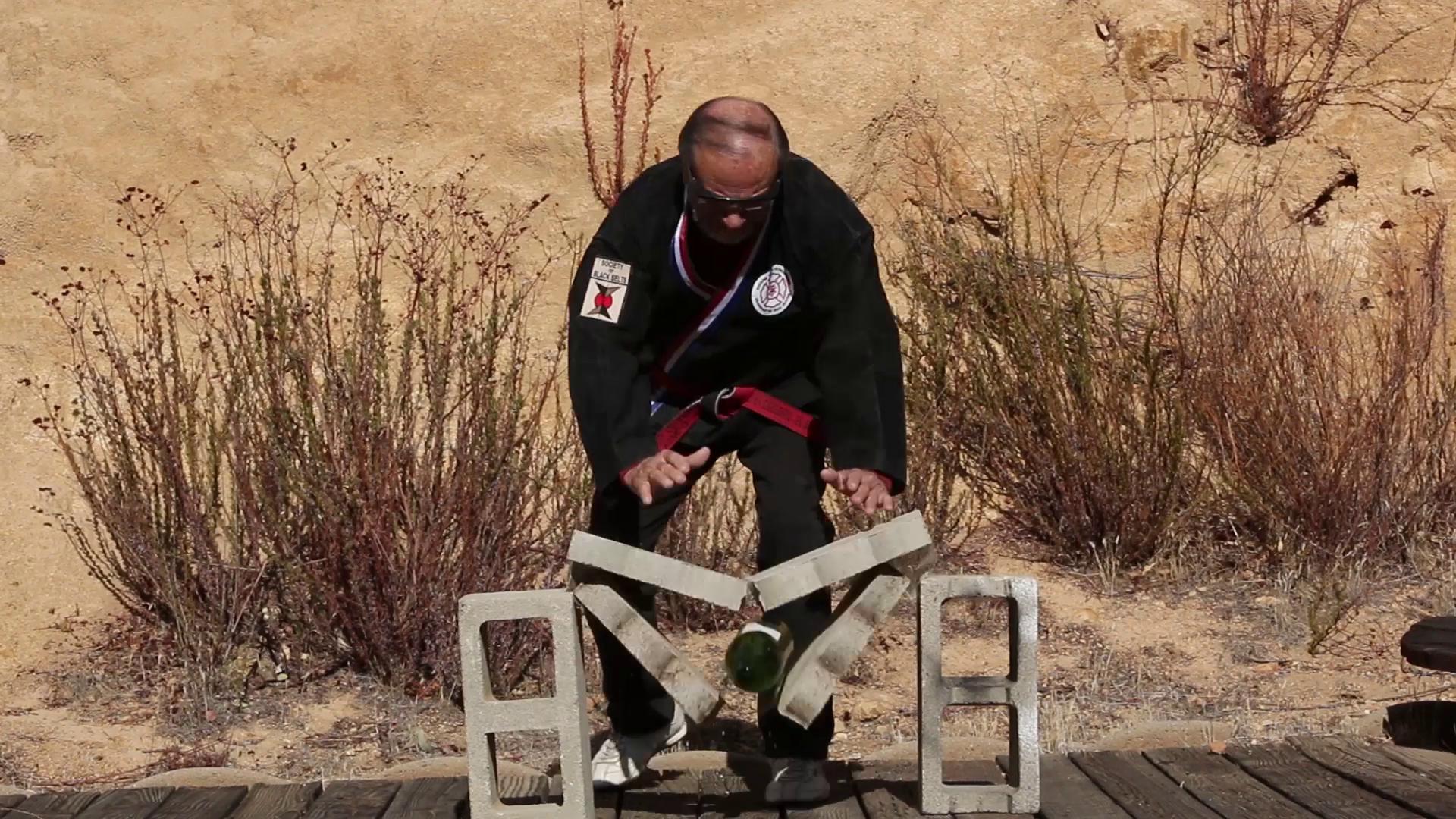Grand Master Olivier began his seminar with a brief history of breaking. He highlighted the following points.
- Tibetan monks started the art of breaking.
- Shaolin monks continued developing the craft.
- GM Olivier’s breaking art comes from the Shorinji Kempo system.
According to the Grandmaster, warfare is the crucial element in a martial way. Without conflict, the need to develop weapons is non-existent. Therefore, the martial way is about war.
Grandmaster said a breaking artist must develop the hand and body as a weapon. They must have proper physical development before breaking. This development conditions the body for impact. It prevents injury. Grandmaster warns against break training when you have injuries, infections, or other problems. The practice may aggravate the injury.
A bowl of Dit Da Jow (ointment used to harden and heal the skin during iron fist training) was passed around for the students to massage into their hands. Grandmaster continued with his seminar by describing Chi.
The center of Chi is the tan tien (Japanese: Hara or the fuel center) just below the navel.
- There are seven points, the seven chakras, as centers of Chi in the body.
- Chakra is the wheel of energy, a magnetic field just like waves. A chakra is a pool or center of Chi at the junction of meridian lines.
- Meridian lines are channels in the body where the Chi flows. Acupuncture uses needles along these lines to maintain Chi flow and body health.
- The kundalini is the most potent source of Chi located near the tailbone area. The kundalini technique opens all seven Chakras to awaken a serpentine Chi flow in the body.
The chi energy is like sound waves (as in chanting). Grandmaster said low-frequency waves are the most destructive. The monks used these techniques to fight. These techniques became legendary, known as:
Dim Mak
A technique of Dim Mak (death touch) that “…is depicted as a secret body of knowledge with techniques that attack pressure points and meridians, said to incapacitate or sometimes cause immediate or even delayed death to an opponent. Little scientific or historical evidence exists for a martial arts’ touch of death’. However, it has been confirmed that trauma may cause disproportionately catastrophic consequences when applied to known pressure points under specific circumstances [1].”
There are several techniques of Dim Mak Striking such as:
- Vibrating palm
- Poison hand
- Divine Immortal Palms
- Iron Bone Shattering Palm
- Cotton Palm
- Burning Palm
- Spiralling Palm
- Tibetan Fire Palm
Breaking is dangerous. It would be best if you broke correctly or you’ll become injured. Grandmaster warns against learning or practicing breaking without a proper instructor and guide. If you become injured or wish to know the therapeutic aspects of “breaking”, seek Chi-based healing. Grandmaster said Reiki healing is excellent, as is acupuncture healing. Reiki is a method of spiritual healing using sounds, symbols, and Chi manipulation.
Conditioning (Iron Fist Method)
Here is Grandmaster Olivier’s Iron Fist Training Method [2].
- Get a 24″ diameter, 10″ deep bucket. Fill it with sand.
- Pound (punch) the sand with your strike for 10-15 minutes non-stop for five days. Be sure to train your other side too.
- Do this for one week.
The next level, use frozen peas or pinto beans.
- Pound the beans for 10-15 minutes non-stop for five days. Be sure to train your other side too.
- Do this for one week.
Intermediate Levels:
- The next level is two weeks long, using a mix of 50% gravel and 50% beans.
- The following two weeks will be all gravel.
- The mixture is 50% gravel / 50% buckshot or BB pellets in the next two weeks.
- The final two weeks are all BB pellets.
Before each workout, rub your hands with Benzene (tough skin), Betadine, or brine. Be sure to cover and coat the knuckle area thoroughly. As always, consult your instructor for proper technique.
The ten-week regiment is complete, and you have correctly trained iron fists. You can practice your breaking drills and such. Grandmaster suggests you break no more than once every three days. This schedule will allow your body to heal.
It would be best if you had a cocoa fiber mat wrapped around a post, a makiwara pad at the higher levels. For three months, punch the mat 500 times. Turn the carpet around to the bristly side and hit the mat 500 times for three months.
You’ll want to heat the Dit Da Jow to 102° and soak your fist for 5 minutes on each side for this heavy workout. You can soak in room temperature Dit Da Jow for regular activities. The warmth increases the blood flow to your fists. If you have a cut or opening in the skin, don’t soak your fists in Dit Da Jow.
Dit Da Jow Warning
Dit Da Jow shouldn’t have almonds in it because the mixture is poisonous. Dit Da Jow must be two years old before using it. It’ll cost $25-$30 locally, pre-made. It’s cheaper to get the ingredients and make it yourself. Store in a moderate temperature storeroom or garage.
Breath
To break effectively, you must be *well* rested. Always meditate before breaking. Use proper circular breathing (belly breathing).
Visualization is key
Grandmaster Olivier suggested the following scene for your meditative visualization.
The boy is throwing rocks into the pond, but there are no ripples.
Just be in this place. See and experience what happens. There is no wrong or right image. See what happens when the boy throws the rocks into the pond without splashes.
After this meditation, do this:
- Breathe in right nostril, out through the mouth with the tongue on the upper palette. Repeat three times.
- Breathe in the left nostril, out through the mouth with the tongue on the upper palette. Repeat three times.
- Breathe in through the nose, out through the mouth with the tongue on the upper palette. Repeat three times. This cycle is called circular breathing.
Return to regular circular breathing (#3) with this visualization:
A silver dollar-sized black spot is on your Hara. It shrinks and compacts to the size of a quarter as you breathe. Breathe in and visualize the dot rising through your body to your upper chakra. Breathe out through the mouth as the dot descends to your palm. Continue breathing. The dot should become heavy. Now, breathe in. The dot should rise through the body to the upper chakra. Breathe out as the dot descends to the Hara.
This imagery of the dot is the visualization used in breaking. Use the dot imagery to regulate breath and chi flow. When you contact the object to break, the dot should rest in your hand. Before and after the break, the dot should rest in the Hara. You must practice this daily to develop this mental coordination.
Demonstration of Breaks: The Fun Part
Grandmaster Olivier demonstrated several types of breaks.
[image: The three students who broke only the bottom brick. Master Modzak, Master Bagnas, Grandmaster Fugate]
- Two boards on supports. The third board on top against the grain. Grandmaster broke the bottom two only with a quick snap reverse punch.
- He broke the bottom scallop brick of four using a springy palm strike. There was a cloth on the top brick to absorb some of the impacts.
- Grandmaster then popped the ends of bottles out. Water in the bottles stopped at the neck. A cloth was wrapped tightly around the neck. Strike the mouth of the bottle with a palm heel. Pop, the ends burst open.
- A newspaper held down a thin piece of lattice on a table. A quick shuto strike broke the wood in two. The remaining portion of the lattice remains on the table under the newspaper.
- He showed the burning brick break. Three scallop bricks with spacers were lit on fire using cigarette lighter fluid. Grandmaster broke the bricks with ease. He warned against having sleeves and other flammable items on the arms to prevent burning.
- Grandmaster demonstrated brick and rock breaking on an anvil or railroad track. He started by holding a brick on the left and performing a shuto with the right. Grandmaster broke several masonry bricks and two medium rocks.
- His assistant held a phone book over his stomach. Grandmaster willow palmed his assistant through the phone book. When the assistant lifted his shirt, a red handprint appears. It got darker as the day progressed.
Grandmaster Wilson demonstrated several breaks to the crowd also. The crowd gasped in unison when he broke several large rocks with his bare hands. Wilson discussed some of the training routines from the Shaolin Goju system. I didn’t record these routines in my notes, unfortunately. I now forgot what he did; however, it was great. Trust me.
The three attending Grandmasters (Olivier, Wilson, and Fugate) charged the atmosphere with camaraderie, guidance, and excitement. Everyone had a great time learning the art of breaking. Splintered boards and crumbling bricks littered the parking lot.
Grandmaster Olivier tempted the audience with a coconut break at the next breaking seminar. I’m sure the students will return to learn from this breaking master.
Bibliography
[1] Dim Mak; https://en.wikipedia.org/wiki/Touch_of_Death
[2] Iron Palm; https://en.wikipedia.org/wiki/Iron_Palm



